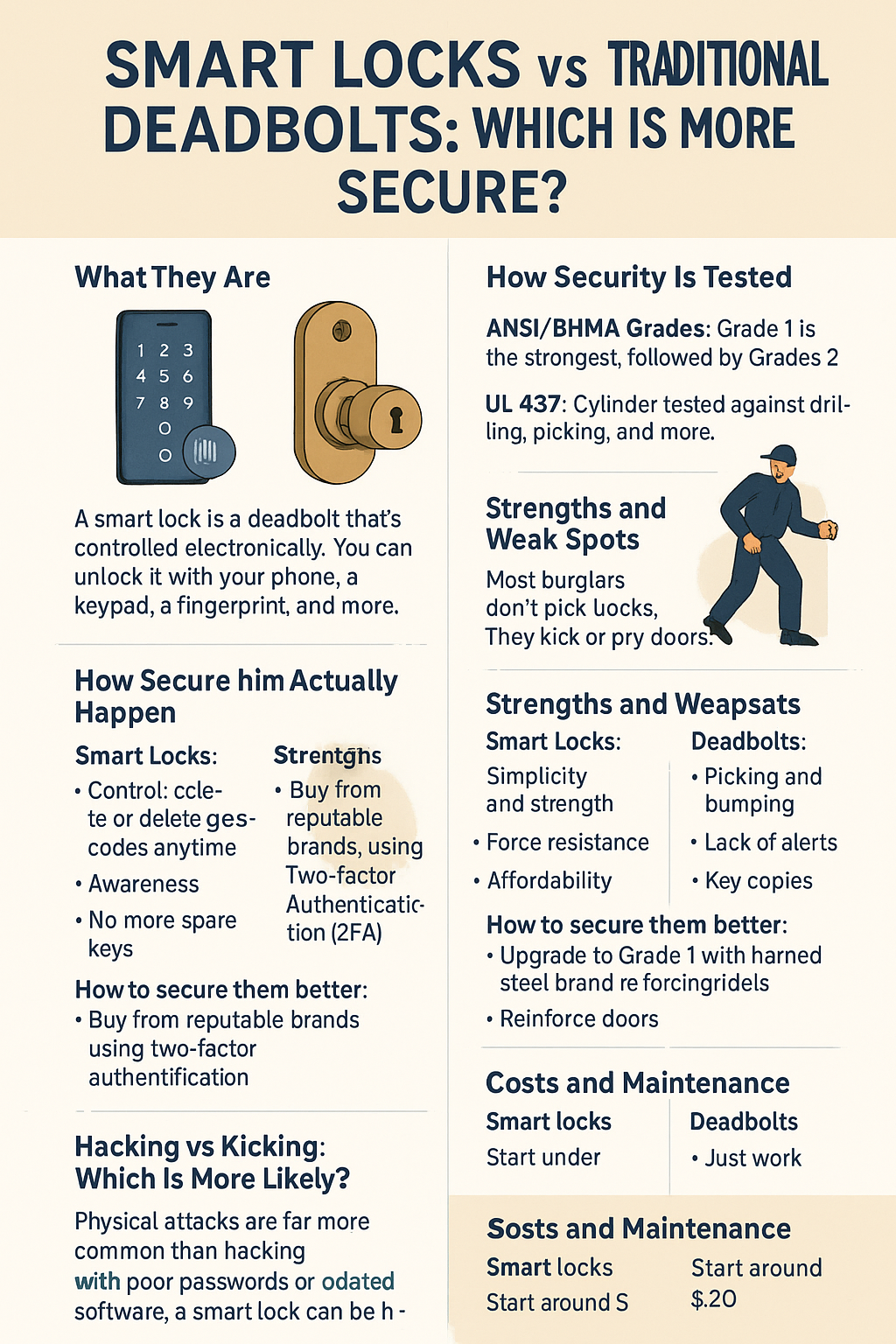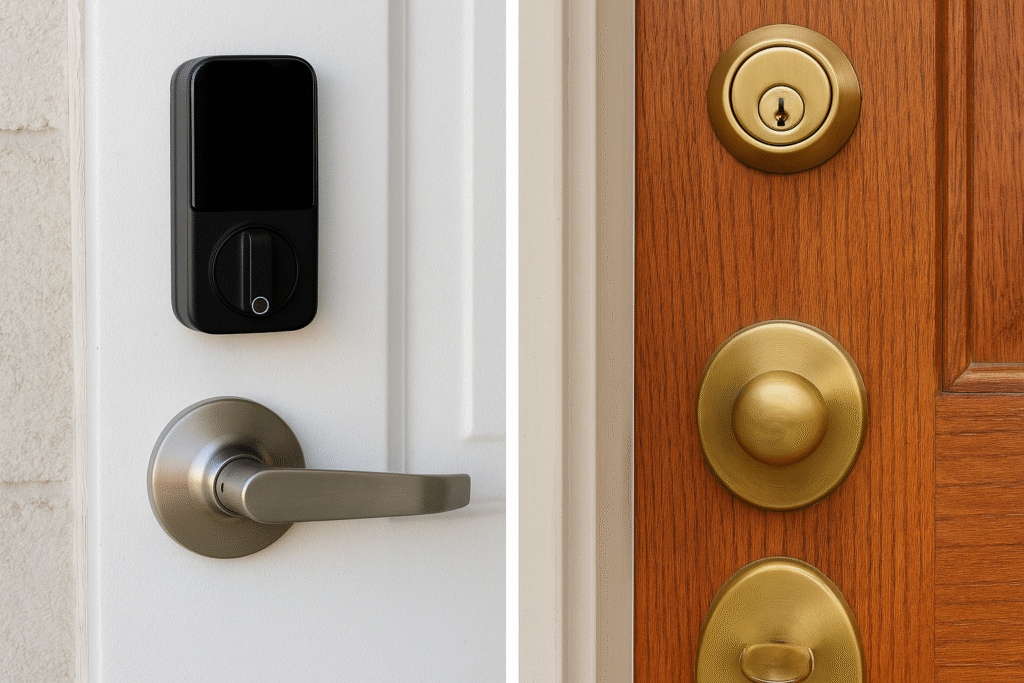Introduction
Imagine this. You’re juggling bags of groceries, your dog’s barking, and your phone won’t stop buzzing. You nudge the door, and it unlocks because your phone’s in your pocket. Pretty slick, right? That’s the promise of a smart lock.
Now think of your granddad’s deadbolt. Solid steel, no batteries, no app crashes. It’s old-school tough.
So which one is really safer? In this guide, we’ll break down smart locks vs deadbolts in plain English. We’ll cover real break-in risks, costs, ease of use, and who each lock fits best. By the end, you’ll know which option makes the most sense for your front door.

What They Are
Smart locks
A smart lock is a deadbolt with brains. It still has a bolt that slides into your doorframe, but it’s controlled by electronics. You can unlock it with your phone, a keypad, your fingerprint, or even your watch.
Smart lock types include:
- Bluetooth smart locks (connect to your phone nearby)
- Wi-Fi smart locks (remote control from anywhere)
- Keypad smart locks (code entry, no phone needed)
- Biometric smart locks (fingerprint or palm scan)
Most are smartphone controlled locks. Some sync with Alexa, Google, or Apple Home.
Common smart lock features:
- Unlock from anywhere
- Auto-lock and auto-unlock
- Temporary guest codes
- Notifications if the door’s left open
- Logs of who came and when
- Low-battery alerts and backup options
Traditional deadbolts
A deadbolt is the strong, metal bolt that slides into your frame when you turn the key. It’s simple, mechanical, and reliable.
Deadbolt types:
- Single cylinder (key outside, thumbturn inside)
- Double cylinder (key on both sides)
- Jimmy proof (surface-mounted, extra pry resistance)
No apps. No updates. Just raw strength.
How Security Is Tested
Locks aren’t just guesswork. They’re tested.
- ANSI/BHMA Grades: Grade 1 is the strongest, followed by Grades 2 and 3.
- BHMA letter ratings: A = best. You’ll see ratings for Security, Durability, and Finish. A lock with AAA is top of the line.
- UL 437: Means the cylinder is tested against drilling, picking, and other attacks.
When shopping, look for Grade 1 or higher ratings. It’s the gold standard.
How Break-Ins Actually Happen
Most burglars don’t pick locks like in spy movies. They kick the door, pry the frame, or find an open window.
That’s why your door, frame, and strike plate matter as much as the lock itself. A Grade 1 deadbolt on a hollow-core door is like a steel chain on a paper box.
Quick fix:
- Install a heavy-duty strike plate with 3-inch screws
- Use solid-core or metal exterior doors
- Add a latch shield if hardware feels loose
Smart Locks: Strengths and Weak Spots
Strengths
- Control: Create or delete guest codes anytime
- Awareness: Notifications when doors open or close
- No more spare keys: Lose a phone? Revoke access instantly
- History: See who came and when
Weak spots
- Hacking risks: Wi-Fi and Bluetooth can be vulnerable if not updated
- Batteries: If you ignore the warning, you could be locked out
- Keyhole weakness: If it has a cheap cylinder, it can still be picked or bumped
- Connectivity issues: Wi-Fi can drop; radios can be jammed
How to secure them better:
- Buy from reputable brands that offer regular software updates
- Turn on two-factor authentication (2FA)
- Use unique, strong passwords
- Pick models that use Thread or Matter (better battery life than Wi-Fi)
- If it has a keyhole, make sure it’s Grade 1 with an upgraded cylinder
Deadbolts: Strengths and Weak Spots
Strengths
- Simple and strong: Nothing to hack, nothing to charge
- Force resistance: A Grade 1 deadbolt with proper screws is a tank
- Affordable: Tough locks without the price tag of electronics
Weak spots
- Picking and bumping: Cheap cylinders can be defeated by skilled thieves
- No alerts: You won’t know if it’s left unlocked
- Key copies: Once someone has your key, it’s game over unless you rekey
How to secure them better:
- Upgrade to Grade 1 with hardened steel inserts
- Look for UL 437 cylinders for extra resistance
- Reinforce doors with longer screws and door wraps
Hacking vs Kicking: Which Is More Likely?
For most homeowners, physical attacks (kicks and pries) are far more common than hacking. Still, with poor passwords or outdated software, a smart lock can be hacked.
Bottom line:
- If you keep your smart lock updated and secured, hacking risk is low.
- If you reinforce your door and use a Grade 1 deadbolt, physical break-ins get much harder.
Installation and Reliability
Smart locks
- Most are DIY-friendly
- Retrofits fit over existing deadbolts
- Full replacements need more setup
- Requires app setup and firmware updates
Deadbolts
- Easy to install with basic tools
- Common mistakes: misaligned holes or shallow strikes
- Once installed properly, they work for decades
Reliability:
- Smart locks depend on batteries and software
- Deadbolts just work, year after year
Costs and Maintenance
- Smart locks: Budget models start under $100. Premium biometric or Wi-Fi locks cost $200–$300+. Don’t forget battery replacement.
- Deadbolts: Basic ones can cost $20. Premium high-security models may reach $100+. Maintenance is minimal.
Insurance and Peace of Mind
Some insurers give small discounts for smart home security systems, including smart locks. Even if not, documenting your setup and keeping receipts helps with claims.
Who Should Choose What?
- Homeowners: Smart locks with Grade 1 bolts for convenience and security.
- Renters: Retrofit smart locks or strong mechanical deadbolts (if allowed).
- Businesses: Smart locks with biometrics or keypads and audit trails.
- Elderly users: Keypad smart locks with auto-lock and large backlit numbers.
- Tech-savvy users: Smart locks with Thread, Matter, or Apple Home Key.
- Low-maintenance seekers: A Grade 1 deadbolt with frame reinforcement.
Buying Guide: 2025 Picks
Smart locks: Look at Yale, Schlage, August, Kwikset, Ultraloq, Nuki, Aqara, and Eufy. Favor models with Matter over Thread for battery life.
Deadbolts: Choose Grade 1 deadbolts from Schlage, Medeco, Mul-T-Lock, Yale, or high-end Kwikset lines. Add reinforcements for extra protection.
Stories That Say It All
The busy family: Installed a keypad smart lock with auto-lock. Panic about forgetting to lock? Gone.
The small business: Used a biometric smart lock with audit logs. No need to chase old keys when staff change.
Grandpa Ali: Stuck to a Grade 1 deadbolt with long screws and a peephole. No batteries, just brute strength.

Conclusion
Your front door’s safety isn’t about smart vs old-school. It’s about the whole system: lock grade, door, frame, and how you maintain it.
- Want simple, budget-friendly toughness? Go with a Grade 1 deadbolt and reinforce the frame.
- Want security plus convenience? Choose a Grade 1 smart lock with updates, good passwords, and auto-lock features.
Either way, pair it with a strong door and strike plate, and you’ll sleep easier.
